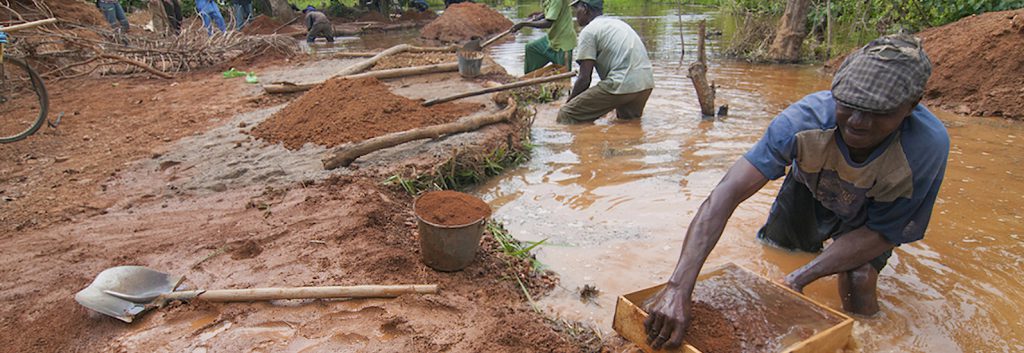Next steps for artisanal and small-scale miningÂ

By Gordon Feller
Unbeknownst to many in the mining industry, artisanal and small-scale mining (ASM) occurs in approximately 80 countries worldwide.
In 2019 there were more 100 million artisanal miners globally. ASM mining production accounts for 80% of global sapphire, 20% of gold mining and up to 20% of diamond mining. It is widespread in developing countries in Africa, Asia, Oceania, and Central and South America.
Although the informal nature of the operation, and its largely un-mechanized nature, generally results in low productivity, the sector represents an important livelihood and income source for the poverty affected local population. It ensures the existence for millions of families in rural areas of developing countries. Indeed, about 100 million people – workers and their families – depend on artisanal mining compared to about 7 million people worldwide in industrial mining.
Job creation is a key element of the picture here. The global employment gap has renewed discussions on how jobs are defined and created. Artisanal mining has grown from 10 million workers, as counted in 1999, to upwards of 30 million in the field today. How to make available the necessary knowledge and technological resources which will increase productivity - coupled with much better social protections and fair labour standards at the workplace?
Rural development is another key element. This is closely linked to the job agenda. Artisanal mining’s added value is part of rural livelihood diversification strategies where it is one avenue of income generation. Research has shown how artisanal mining assists rural households in building more dynamic and resilient livelihood strategies portfolios by, for instance, ‘dovetailing’ artisanal mining and farming economies. Further, it is a stimulus for trade and subsidiary business development around mine sites just as evidence in industrial or larger-scale mining operations.
The question of linkages – how mining interplays with other aspects of local economies – and how to promote better integrated rural development strategies to capture mineral benefit distribution is equally an important question linked to artisanal mining.
New partnerships are needed, in order to assist governments as they address the problems associated with artisanal mining. Some of the smarter national governments are organizing artisanal mining technical assistance programs. The World Bank’s Africa Governance Initiative provides national governments with mining experts to build the national capacity to address the problems associated with artisanal mining – especially in such countries as Rwanda.
The International Finance Corporation is extending its business advisory service tools to include an artisanal mining checklist for baseline studies for its investment partners. The Kimberly Process adopted in 2012 an “ASM for Development” framework, to be implemented by its member states. The African Union recognized ASM formalization as one of its six areas of engagement under its 2011 Africa Mining Vision. Other partners include the German Government’s GIZ, the Australian Government’s AusAid and the Canadian Government’s CIDA. Each is working not only with national governments but equally with NGOs, in addition to regional governmental institutions.
The London-based research teams at International Institute for Environment and Development estimate that 15-20% of global minerals and metals derive from artisanal mining. Though globalization of mining processes is not new, it has led to new sourcing of raw materials in resource-rich but also more isolated areas of sub-Saharan Africa, Latin and South America, and South East Asia.
This more pronounced penetration of mineral buyers and small investors into isolated regions of the world gives rise to further concerns over how artisanal mining is both impacted by these markets demands, and accordingly responds. Piloted efforts to model clean supply chains, or fair-trade minerals, are re-emerging as a means to diffuse the principle of responsibility across the supply chain – whether companies, manufacturers, smelters, buyers and traders, and national governments.
Sustainable and responsible natural resource management – which protects habitats and biodiversity – is being hurt by the current approach. The global rise in specific mineral prices, such as gold, has precipitated recent pockets of mining rushes worldwide. Some of these environments include previously untouched places that are ecologically sensitive, including protected areas and critical ecosystems such as Arctic landscapes (Greenland), tropical rainforests (Brazil and Gabon), and coral reefs (Philippines). Environmental impacts of mining methods, for example, clear-cutting forests, river dredging, or use of toxic chemicals, are compounded by livelihood practices that support mining populations such as gathering firewood, hunting for food or trade of goods.
On a global scale, artisanal and small-scale forms of gold production remain the biggest environmental challenge, and it is largely due to mercury use. A new UN Treaty to further limit and in some cases ban mercury use in-countries is an opportunity to tackle its use in ASM. However, the environmental agenda surrounding ASM must be integrated into broader governance discussions as often environmental degradation caused by ASM occurs within a vacuum of government regulation and presence.
In the coming months we should be looking closely at some key challenges: private sector partnerships; the contribution made by artisanal mining in fragile countries; the status and protection of women in such environments; pilots which assist mining companies to evolve their own artisanal mining strategies, to mitigate the risks potentially associated with their activities. The key focus is to identify opportunities to improve the impact of mining projects.
